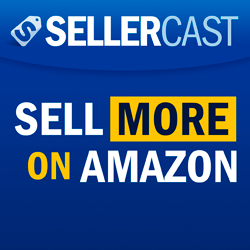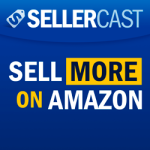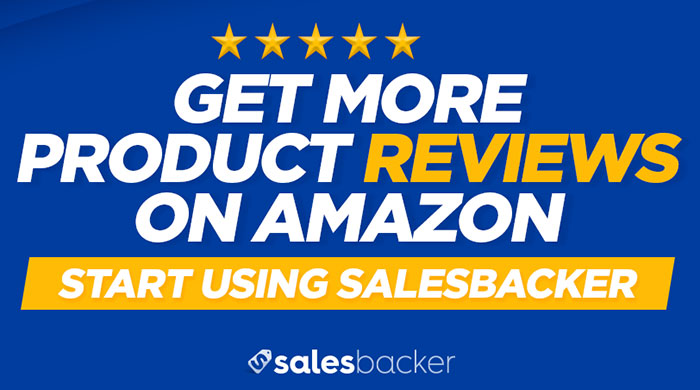 Direct podcast MP3 download link
Direct podcast MP3 download link
Like the show? Get new episodes on iTunes or Stitcher
Spencer Haws joins us today to talk about how he built a six figure Amazon business from scratch in 2015. By now you've heard from multiple sellers that have been successful selling on Amazon, but every guest we bring on the goal is for them to share something unique about how they built their business and today's episode is no different.
In Spencer's case, he's picking products most people ignore (sea shipped oversize items) and driving some extra sales from a website he's already built and ranked in Google. Most Amazon sellers that I speak with are primarily relying on only Amazon traffic to drive sales, but Spencer is already seeing several hundred unique visitors a day to his website which we also talk about on this episode. I'm sure you're going to enjoy what he has to share.
Want to ask a question?
Get involved and ask a question about selling on Amazon and Chris may answer your question live on a future episode of Sellercast. Also, if you think you'd be a good guest for the Sellercast podcast feel free to tell us more about you and your company here.
Need more product reviews?
If you'd like to get more reviews for your products on Amazon check out Salesbacker.
Show Notes and Links
- NichePursuits.com (Spencer's blog)
- LongTailPro.com (Spencer's keyword software)
Podcast Transcript
Intro: Hello everyone. Chris Guthrie here, host of Sellercast. In today’s episode, I speak with Spencer Haws, a longtime friend of mine and blogger over at NichePursuits.com. Spencer has unique background because one of the things he’s going to talk about in today’s episode is that he’s already started building and ranking a website in Google and getting a fairly substantial amount of traffic that he’s then using to drive back to the proxy he’s selling on Amazon. This is unique amongst the guests that I’ve had on the show so far. So make sure you stay tuned for that. And if you want to see the show notes, go to Sellercast.com/13 so you can get links to all the different resources that spencer mentions in this episode. And finally, Spencer is actually a longtime user of Salesbacker. So if you’d like to use the exact same tool that he credits in this episode helping him get more product reviews, you can go to Sellercast.com/now to start your free 60-day trial. So check that out. And let’s start the show.
Chris Guthrie: Hello everyone. Chris Guthrie here, host of Sellercast. And in today’s episode, I have a good friend of mine, longtime friend, actually, years now. Spencer Haws is on the podcast. Thank you for coming, Spencer.
Spencer: Absolutely, thanks, Chris. I guess it has been a while.
Chris Guthrie: Yeah. I was trying to recall back as I was talking there how many years we’ve known each other. But yeah, it’s great that you’re here. It’s great too because I know that you’ve been selling for a while on Amazon. You’ve been really enjoying the business model. But how long have you been selling on Amazon for?
Spencer: I officially got my first product up, I think, around March 1st of 2015. So it’s been whatever that equals out to be, 8 months or something like that. I started the research process, and started sourcing the product probably January of this year. So almost one year, I’ve really started the business.
Chris Guthrie: Yeah, okay. I definitely know the answer to this question I want to ask you. But for people that aren’t familiar with you and your blog and everything else you’ve been doing for so long, what were you doing before you started selling on Amazon?
Spencer: I do have a couple of other online businesses. Of course, I do have my blog at NichePursuits.com. And then I have a software product, a keyword research tool called Long Tail Pro. So those are big pieces of my business. But I really started out back in the day, 2006-2007, building small niche websites, just trying to rank for very specific key terms. And I built up a large website portfolio. In 2011 is when I finally was able to quit my day job and just focus on my websites. And I guess it was kind of 2011 that I launched NichePursuits and Long Tail Pro. I built those businesses in addition to all my other websites as well. So I just have several different little online businesses going. And then this whole Amazon thing came around, and it’s been a fun ride so far.
Chris Guthrie: Yeah. So let’s talk a bit more about that. You have these other businesses that are doing well. I know that people use Long Tail Pro to help get keywords for use within your Amazon listings, for example. But why did you even bother going into this space? It’s entirely different. When you’re selling physical products, it’s much different than digital, of course. And I’m sure we’ll talk about this. When you’re dealing with physical products, you obviously have inventory issues you get to manage. So what actually made you decide to start selling on Amazon then?
Spencer: Yeah, it was kind of interesting because I started seeing a lot of other people having success selling on Amazon. And I honestly didn’t know hardly anything about this business. I didn’t quite understand that it could be 100 percent hands-off like on online business. I always assumed that if you were selling a physical product, you needed to store that in your own warehouse or in your garage, and you had to package that and ship it yourself – actually take the boxes and sell this. And so I was like, “Well, that’s not a business I ever want to do. I don’t want to physically, like, DO something, right?”
Chris Guthrie: [Laughs] Yeah, I thought that you’d like to run. This sounds like you’re trying to avoid working out.
Spencer: I have my exercise time and then my business time. So the light bulb went off when I started reading that other people were having success. And somewhere along the line, it finally clicked that this really can be like an online business. You don’t have to touch the inventory. You just have to send some emails, essentially, to get the product created in China. So it all sort of came together that hey, this can be, in a way, a more passive type business. I don’t have to be packaging all these things myself. And I saw the upside potential that a lot of other people were having. So that just got me really, really interested.
Chris Guthrie: That’s awesome. Yeah, I mean that’s the thing. Using Fulfillment by Amazon is a huge part of that. But I’ve since learned that there are companies that you can still talk to, and they can handle your fulfillment for you. But the main advantage, of course, with Amazon is that you get access to those millions and millions of Prime members that just absolutely love the free two-day shipping type of thing.
Spencer: Yeah. So for me, it was just almost getting educated on the business. I just didn’t understand how it worked. And once I understood, yes, fulfilled by Amazon, I mean that’s just huge. And you can have a logistics company basically get it from China to your house or to Amazon. It just really can streamline the entire business. So once I got educated, it became really appealing. And that’s how I got started as far as becoming interested in the business.
Chris Guthrie: That’s awesome. So you basically saw there’s an opportunity, and you went for it. Certainly, you’ve leveraged the fact that you’ve done other successful businesses. I think in general, if you’ve done something before, then it helps to give that confidence to try something, even if it’s entirely outside of the range you’ve done before, and to get after it.
Let’s talk about your success before then. Where are you at sales-wise? At the time of recording this, it’s like the day before Thanksgiving. We’re going to publish this in December. Where are you at before as you head into Black Friday and the craziness that will occur then?
Spencer: As far as overall monthly sales volume?
Chris Guthrie: Yeah, what are you doing on average per month now?
Spencer: I’ve had some higher months and some lower months, but right now I’m about $20,000 a month, at least in the latest month and a half or so. I’m kind of working through some of those issues. Basically, when I’m running on all cylinders, when I had all my products in inventory, I had $40,000 a month. But then I ran out of inventory, and I only had a couple of products in stock out of 5. Basically, with those inventory issues, I’m at about $20,000 a month. I just got new stock in, so I should be fine right now, running on all cylinders starting now, just in time for Black Friday. So December should be a really good month. We’ll see where it ends up, but I’m expecting good things, definitely my highest month ever, hopefully.
Chris Guthrie: That’s awesome. It’s funny because this is a recurring theme when I talk to anyone that sells on Amazon, especially if I’m talking to someone that’s just starting out. You’ve been selling for less than a year. When I first started selling, they either get the product up, and then they can’t keep the products in stock because it’s just doing really well. Or they can’t get their initial sales to even get off the ground in the first place. So there are really vast gaps between the two. And then it’s rarer to find someone that’s right in the middle, and they’re able to manage to get the stock. The biggest challenge really is selling better than you expected. So it’s a challenge to keep it in stock. How would you try and handle that problem? Because obviously, if you can solve it, you’re going to be making considerably more money and growing that business even faster.
Spencer: Yeah. I do think that I’ll be able to solve it. And hopefully, it solves now. But it was the issue of things just sold faster than I thought. With my product, I’ve always had to do… Because I sell an oversized product – I will share that – I’ve had to do shipping via ocean freight, which is much, much slower than air. So that’s part of the problem, that there is huge lead time, basically a couple of months. It takes them a month to create the product, and then it takes a month to ship it, essentially, and to get it into stock. So there’s this huge lead time.
And when I first started selling on Amazon, I didn’t go out and order thousands and thousands of units. I wanted to test the product and see if it would sell well. So all of my initial orders were fairly small. And I still think that that was a smart think to do because if it didn’t sell at all, I would’ve been stuck forever with a bunch of inventory if I had ordered some huge batch. So I ordered very small batches of inventory. And they sold a lot quicker than I was expecting. And so by the time I got around to reordering, I basically already knew it was going to be out of stock for like two months. So that’s essentially what happened here. As mentioned, I do have five products now. So I got the first product figured out. And by the time I added the second through the fourth, I was just testing those. And those went out of stock really quick. And that’s where I’m at. I’m getting my second order for all these other products back in. And I think I hopefully will have it figured out now. I ordered a much larger batch, so I know that those will be in stock, and I can calculate out that two-month lead time when I need to reorder.
Chris Guthrie: When I talk to people that are already successful in the past or they have access to capital that they can use in this business, a couple of different camps come up. One is the approach that you just mentioned, where you start with lower inventory, even though you have the capital so that essentially, if it fell apart, it’s unfortunate to lose that money, but you have other successful businesses that can help drive that and replenish those reserves.
And then I talk to some people that just go like nuts. I talked to someone at a conference a while back. They put in like $30,000 in their first product. I’m like that’s way too much. That’s way too much to do.
Spencer: I can see it going either way. I took a very conservative approach. I am now seeing some success. So I feel like if I did another new product, I probably would be a little more aggressive, just because I’ve proven out the model to myself a little bit more. And yes, I do have access to a little more capital than somebody just starting out. So you really can go either way. I would never say go overboard. $30,000 is a little crazy. But you could maybe get a little more aggressive if you have the experience and capital and that sort of thing.
Chris Guthrie: Yeah, hopefully, he’s done his research well. That was the question I was going to ask. Now that you’ve proven that it works for you, if you are going to go ahead and try to do a larger order for your future products. But that sounds like that’s on your past.
Spencer: Yeah, I think that I definitely would order a larger batch next time.
Chris Guthrie: There are a few things you mentioned in that previous answer that I want to dive into. One, you mentioned specifically that you’re doing ocean freight. I want to talk about that a bit. And the other is you’re using an oversized product. So are you doing oversized products for all of your products? Or is it just the first one that you started doing?
Spencer: They are all oversized.
Chris Guthrie: Okay, cool. So here’s a good question. I know that when you first start selling on Amazon oversized, they put a limit at 500. And so is it just you started with less than 500 units for your first one. And since you got those initial sales, Amazon was able to see that volume, and they automatically added you. Or did you call them and asked them to increase the volume?
Spencer: I have now had them increase the volume twice, on two different occasions. And I had to contact them. So you’re right. It was a 500. And then I got it increased. I believe they did it to 800. And then I could see that the holiday season was coming up. And I ordered. Now I’ve got 5 products. And I ordered larger batches. And 800 is just not anywhere near enough. So I requested again. It took a couple of requests. I did call them on the phone the second time. And I’m now up to 1600 units they got me approved for. They basically doubled my capacity. So that’s kind of the process.
Chris Guthrie: Yeah. There are not too many people I’ve talked to that have been able to get that increase. But it’s certainly something to be aware of. But even if you are going to sell oversized items, you just kind of work your way up to it. And one thing you can always do is you can actually store that inventory in a separate warehouse, potentially, and then send it in that overtime.
Spencer: And that’s exactly what I’m doing because I’ve ordered way more than 1600 units for the holiday season across my products. And so I’m doing it sort of piecemeal. So I send, like, 300 units of each product in right now on Amazon. And then as those sell, I’ve got the rest of the inventory stored at a warehouse in L.A. or just outside of Amazon warehouse or whatever, that I can get to Amazon within a couple of days real quick.
Chris Guthrie: Okay, that’s great. And I think doing oversized items is a bit unusual. A lot of people that I talk to, especially for the first product, start out with something small, lightweight, that can be air shipped etc. If you look at any courses – I don’t have to go into the courses – every course out there seems to talk about lighter air shipped items as a starting point. I guess the idea is that maybe people get their initial success with one item. They can see that yes, you can sell these products, and then they use that confidence and maybe some of the capital to go off and do something that’s more challenging or that’s oversized, whatever, and then … straightforward. Do you think that that’s part of why you’re successful in the sense that there are just less people going after those types of categories? I guess depending on how you answer this, maybe you have some more competition down the line.
Spencer: [Laughs] Yeah, it could be that there is some less competition there. The reason I went oversized is… To be honest, I didn’t take any course. I didn’t do a ton of research into the business other than reading some blog posts and listening to some podcasts. I had a couple of people on my podcast. And I figured, “You know what? I’ve run businesses in the past. I know what I’m doing.” And so I just went for it. And actually, the product I found was one that met my own personal need. It just so happened that hey, I like this product. I can’t find exactly what I want on Amazon. Why don’t I just create this and list it up on Amazon? And it happened to be an oversized product. So that’s why I did it. But there could be some benefits there of perhaps there’s lower competition, not a ton of new people are going into this category, that sort of thing.
Chris Guthrie: Yeah, okay, that’s great. And this leads into the other question of how you picked your first product. It sounds like it was just something you personally wanted or had a need for.
Spencer: Yeah, basically. I did do a lot of research. And the idea kind of popped into my head, I don’t know exactly why, other than I’ve had a similar product to what I’m now selling, in the past, that I purchased somewhere else, not on Amazon. And I basically wanted to replace this. So I went to Amazon. And try as I might, I couldn’t find exactly what I was looking for. So I thought, “Well, if there are a lot of people liking this particular feature set of this product like me, and they can’t find it on Amazon, all these other people, I might as well create it and sell it.” So that has worked really well.
Chris Guthrie: Yeah. That’s definitely different than everyone doing the exact same product. I think that for a lot of people, especially people that are just starting out, that’s a common mistake. They see there are a lot of products being sold. And they figure this is the exact same thing. In the short term, yes, even if there are a lot of people selling something, you could still be successful with that. But over the long run, it’s going to be more challenging to make that sustainably last. So it’s great that you started off well in that regard.
One of the questions I actually had was about the ocean side. I’ve talked to people that do ocean shipping. How did you handle? Was it just an additional logistical challenge? Or do you use a freight forwarder? How did you manage that type of shipping?
Spencer: Yeah, I did use a freight forwarder to handle all that. And that really is a lifesaver because they go out and they arrange the shipping, of course, from China to the U.S. And once it gets to the dock in the U.S., they go through. And on your behalf, pass it through customs and pay any tariffs or fees and go through all that paperwork once it hits the dock. And then they take it. They get it into their warehouse, and then of course forward it on to Amazon once you’re ready to do that. So having a logistics company, a freight forwarder, in place is the only way to do it. Having to do it on your own would be a nightmare.
Chris Guthrie: Yeah, I think it’s one of those things where even if you pay a little bit more, it’s worth it. But then maybe once you’re at a much, much larger scale, then it’s okay. You can have an employee that’s in charge of managing all of your sea shipping. But even then, it still might be don’t bother with that.
Spencer: Yeah, I would have to be down the road quite a bit before I even thought about that. Yes, the fees are more, so you have to consider that. If there’s enough margin there… In my particular case, the margin is fine on the product. So it just makes my life easier. So it’s worth the little bit extra money I have to pay.
Chris Guthrie: Okay, so that’s how you did your first product. And then you expanded into four other products. Did you stay within the exact same niche? Or did you go out into other areas to just explore some other opportunities?
Spencer: No, I stayed in the exact same niche the whole time at this point. The first product sold well. The margins were good. And there are a lot of other opportunities within the same niche. So I figured, “Why not? It makes sense for my brand.” So that’s what I’ve done. I’ve got four additional products in the same category.
Chris Guthrie: Okay. So everything you sourced, you used Alibaba. Or did you use some other type of sourcing?
Spencer: Yeah, I went to Alibaba and was able to find manufacturers there just fine.
Chris Guthrie: Just because I’m always curious about what people do in terms of the number of things they... did you get samples from multiple suppliers?
Spencer: Yeah, I have. I’ve gotten samples from several different suppliers on the different products. And I have narrowed it down to two. I have two manufacturers creating the 5 different products.
Chris Guthrie: Okay. What are your next steps? You’ve been selling for about 8 months. You mentioned that begin of March is when you started selling. 5 products, are you planning to just continue launching product after product? Or are you trying to narrow in, focus on less products, and then just make sure you have plenty of stock, maybe do some variants of those products etc. What are your goals moving forward?
Spencer: I do have some plans, certainly for my existing products. I want to grow and expand those as much as possible. And part of my way of growing my existing products is I’ve created a separate e-commerce website off of Amazon and started building lots of content. Of course, that’s my expertise, if you will, SEO and building websites that rank in Google. So I’ve seen a lot of success already with that in terms of traffic. And of course I have a products page on that site, and that’s driving traffic to Amazon right now.
Chris Guthrie: That’s interesting. Let’s dive into that a bit more because it’s not as common that people do that. A lot of times, I talk to people that are just selling on Amazon. And ultimately, that is a bit of a risk if you’re just relying on that one platform for getting your traffic. But if it’s working and you’re making money, you can reinvest that capital into growing your business and exploring other opportunities. That’s great. So eventually, if you can try and get there, that’s what you do. So you’ve already done that. You mentioned that was your expertise. Where is your focus on for that website? You’re writing content. How much content are you writing? Can you talk about the platform that you’re using for your website etc.?
Spencer: Yeah, absolutely. It’s just a WordPress website right now. And we have focused almost exclusively on content. So initially, we wrote nice, long product descriptions on my products. The 5 products I’m selling got a nice product description, sales page. And like I mentioned, there’s essentially, Add to Cart button. But it’s just taking people to Amazon right now just to make it easy. But other than that, the content is all… We’re reviewing other products in the same category. And we did a ton of keyword research on just lots of different keywords, easy to rank for type keywords, in our niche. If not now, we will very soon have about 100 pieces of content, 100 articles up on the site. The traffic isn’t huge, but we’re up to 250 unique visitors a day at this point, which, I can tell you, does bring in some sales every now and again to my own products. So that’s the plan. Eventually, we’ll probably take it to a full e-commerce where people can check out on our website and do that sort of thing. But that’s the next step.
Chris Guthrie: Okay. So the way those sales are coming through is you’re using Amazon affiliate links, basically.
Spencer: Yes, so we can track that.
Chris Guthrie: That’s great. And everyone I talk to that’s doing significant volume on Amazon, even people that are starting out, they’re finding ways to drive additional traffic to their Amazon listings. And they’re seeing some success with that, both in just the additional sales, but also Amazon seeing those outside indicators like traffic coming to a listing that’s from outside of Amazon and that potentially helping with some of the rankings. I can’t say for certain because I’m not an Amazon search engine expert. And obviously, just like Google, they don’t make those factors public. But that’s great.
Spencer: Yeah. The other thing I’m doing to grow the business is I am expanding into other categories. At least, that’s the plan. Well, I’m doing a little bit of both. I have my 5 existing products. I do have 2 other products in the same category that will be in stock very soon. In fact, I think they’re on a boat from China as we speak. So within 2 to 3 weeks, those will be up. So I’ll have 7 products come mid December. And then the plan is to keep expanding in that category with additional products, but to then try my hand in other niches, other categories outside of that. I expect to do that first quarter of 2016 to launch another couple of products unrelated to my other products.
Chris Guthrie: Okay, that’s a good direction we can go. Are you going to set up a separate company to do that?
Spencer: I am in the process of considering that. I think so. I think I probably will. And I just so happen to have a couple of entities already set up. I could probably basically repurpose one of them to be my other entity on Amazon already. So I most likely will do that.
Chris Guthrie: Yeah. So for people listening, Sellercast.com/3 is an episode that I recorded with a friend of mine that had built and sold two Amazon e-commerce businesses for $365,000 in cash. And that’s exactly what he did. He would set up one business. And it’ll be all wholly just that one thing. And he can just hand it on to someone else, and then completely wipe his hands and walk away. So definitely, I’d suggest that if you’re planning on doing a second business to do that same thing, because otherwise, it’s just so hard to untangle those if you ever want to sell.
Spencer: That’s a good point. So I will say yes. I’m going to do a separate LLC. I just decided.
Chris Guthrie: That’s great. Here we go.
Spencer: I was leaning that way, but definitely now. Because you mentioned selling, and I see that as a really interesting opportunity here. I mean if you think about it, I’ve started in my first category. If I can build that up to, let’s say, $50,000 or $60,000 a month, which is definitely not unreasonable, and run it for another 6 to 12 months, so that I have a year and a half to two years, I could totally go out and sell our business. And that could be really, really interesting. So walk away and have already started a new Amazon in a different category, just put a big chunk of change in my pocket and move on to another category.
Chris Guthrie: Yeah, that’s awesome...
Spencer: It’s a tempting idea.
Chris Guthrie: Yeah, okay, that’s great. Are there any other challenges that you’ve faced in building this business that you suggest others watch out for? You mentioned that you didn’t learn anything from any courses. You read some blogs, listened to some podcasts, had your past business experience that you could leverage. Let’s go with that.
Spencer: Just additional challenges, what are the biggest challenges? The logistics, honestly, is a big part of it, just learning that the lead times – especially if you’re doing ocean freight and that sort of thing – that’s been frustrating, probably almost since day one, that I want this business to move faster. I want it done now. But I have to wait two months before something gets in stock. So that’s been a huge learning curve. And I know we already talked about that. But that’s the biggest X factor in this business, just getting the inventory lead times and staying in stock, getting that all figured out.
There are also some fairly small things, managing reviews and customer support or questions. You do get customers that email you. And sometimes you get negative reviews, and being able to respond to those. And actually, Salesbacker has been good about that because it notifies me if I get a 2-star review or something so I can on top of that right away and can either respond or contact the customer or that sort of thing. So there are some small little management things that don’t get talked about a lot, customer reviews and getting questions from customers. It’s not huge, but if you expand your business, you might eventually have to take an employee on to do that or spend a lot more of your own time doing that.
Chris Guthrie: Yeah, definitely. On the employee side, I was curious, are you using anyone right now in the business that’s helping? Is there anyone helping you on this front as well?
Spencer: Not a lot. I do have a couple of other employees for my other businesses. And from time to time, I do have them help out a little bit. But honestly, I’ve done well over 90 percent of everything. It’s just been me. And at this point, my time involved is not huge at all. I always get annoyed with a couple of customers support emails. Here I am showing how lazy I am, right? But it’s not that huge. A couple of customer support issues a day. And then just making sure the inventory and all of that is taken care of. I’ve handled most of it myself, no problem.
Chris Guthrie: It’s good that you’ve done so much yourself because now you can pretty much probably set up systems in place for a lot of the things you do. You mentioned that it’s not a ton of your time. But then if you start that second company, maybe it’s even an exercise to just say, “Okay, let’s see if I can have this one just under my direction, but have someone else do it entirely.” That’s a suggestion.
Spencer: Absolutely, that would be the plan. As it starts to creep in more and more of my time, I would hire somebody, a virtual assistant or a part-time person, to basically run the business for me. Once I’ve got the products picked and the descriptions written, they can just maintain and manage everything at that point. So that’s a very real possibility down the road.
Chris Guthrie: Awesome. Well, cool, Spencer. Thank you so much for coming on to talk about your business. I know you’ve been doing well really quickly, so I wanted people to hear your expertise. I think the approach that you went with the oversized items was helpful. It sounds like you did a lot of research into something by making sure that the product was more challenging to find on Amazon when you’re trying to replace it for your own needs. And so that was another key element to your success, I’m sure.
Spencer: Yeah, absolutely.
Chris Guthrie: Awesome. Thanks again, Spencer, for coming on and sharing. For people that are listening, you can go to Sellercast.com/13 to check out the show notes and some of the links that Spencer mentioned with his blog and everything else. Thanks again, Spencer, for coming on. And have a great rest of your day.
Spencer: Thanks, Chris. Appreciate it.
=====
Outro: All right, that was the episode with Spencer. You can check out the show notes by going to Sellercast.com/13. And as we end this episode, I want to ask for a brief favor. If you’ve been selling on Amazon for any period of time, then you know what I’m about to ask you. And yes, that is what I would like to ask you to do, to leave a review of the show on iTunes or wherever you may be listening to it, because the more people that review our show, the more people will then be able to find it. And of course some more guests I can bring on to help share secrets with you and strategies that are working for them in growing their e-commerce businesses. So please do take a moment to review. And if you want to listen to any past episodes of Sellercast, you can just simply go to Sellercast.com, and you’d be directed to the episode list. Thank you so much for listening, and I’ll see you in the next episode.





